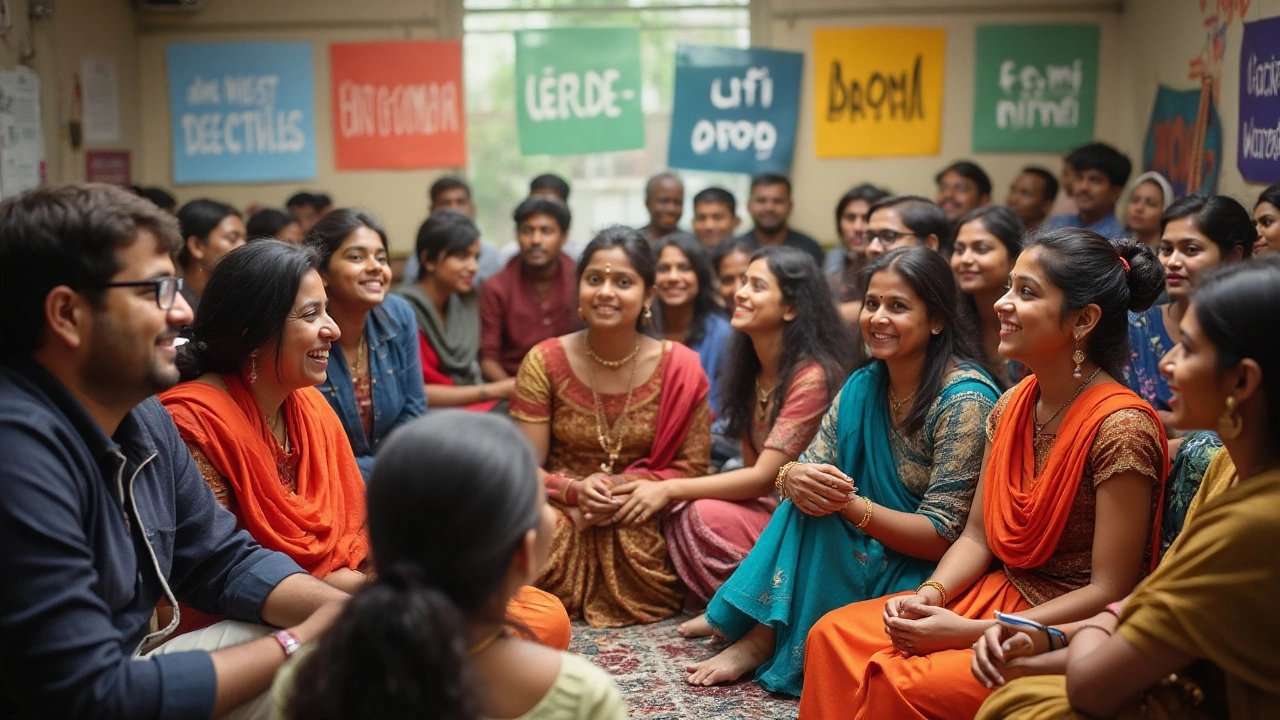
- Created by: Lydia Carmichael
- Completed on: 3 Jan 2025
- Categories: Community Support
In the vibrant world of community outreach, engaging effectively with your audience can be the difference between success and stagnation. The concept of the 5 C's serves as a compass for organizations striving to make a genuine impact. These five pillars—Connection, Communication, Commitment, Collaboration, and Creativity—lay the groundwork for creating lasting, impactful relationships within communities.
Each C embodies a different aspect of interaction that, when executed thoughtfully, can turn an ordinary initiative into an extraordinary journey. Whether you're a grassroots organization or a well-established entity, embracing these principles can transform the way you connect, converse, and collaborate with your audience.
- Connection: Building a Strong Foundation
- Communication: The Art of Effective Dialogue
- Commitment: Ensuring Long-Term Engagement
- Collaboration and Creativity: Working Together Innovatively
Connection: Building a Strong Foundation
Establishing a connection with your community is the cornerstone upon which successful community engagement is built. It's about weaving together a tapestry of trust, empathy, and shared values that invite everyone to feel included and valued. A strong connection isn't formed overnight; it requires persistent effort, genuine interest, and consistent interaction with the community's pulse. At its core, effective connection demands authenticity, a trait that transcends traditional outreach platitudes and speaks directly to the heart of individuals. The process of building such connections begins with listening—truly listening—to the needs, aspirations, and concerns of those you wish to engage.
Consider, for example, the approach taken by the City of Boston's Neighborhood Development program. They sought meaningful community engagement by hosting 'Coffee Hours' in local parks, a simple yet powerful method to bring city officials and residents into an informal setting where dialogue flowed easily. This initiative not only addressed pressing urban issues but also reinforced the human element in governance, opening doors to greater collaboration and support. Such initiatives highlight the critical importance of meeting people where they are, both literally and figuratively, to foster a sense of belonging and shared purpose.
Identify and Understand the Community
To effectively connect, start by understanding the identity of the community. This involves recognizing their cultural intricacies, economic backgrounds, and historical contexts. Each community has its own unique fabric, and acknowledging these differences is key. Not ignoring diversity but embracing it, organizations can foster environments of inclusion that engender a stronger allegiance to community goals. This deeper understanding can often become a catalyst for initiatives that are genuinely impactful and resonate with people's lived experiences. Statistics show that programs tailored to community-specific needs have a higher rate of success in achieving long-term engagement.
Leverage Technology for Wider Reach
In today's digital era, technology serves as a valuable tool for strengthening community connections. By leveraging social media, community portals, and other digital platforms, organizations can extend their reach and facilitate two-way communication. This technology enables the sharing of information, ideas, and updates to a broader audience while also enabling the collection of feedback quickly and efficiently. With 73% of U.S. adults using YouTube and over 69% on Facebook, according to the Pew Research Center, tapping into these platforms can enhance visibility and bring people together, creating a virtual community that complements in-person interactions.
Building these initial ties might seem daunting, but it's worth remembering that even small, consistent efforts can lead to substantial payoffs in terms of trust and participation. As quoted by social activist Gloria Steinem,
"The art of connection is the art of paying profound attention."Emphasizing consistent, personalized interactions can be the differentiator that turns mere awareness into meaningful community support.

Communication: The Art of Effective Dialogue
Engaging in meaningful dialogue is an essential element of community engagement that should never be underestimated. At its core, effective communication involves more than just exchanging ideas; it's about understanding emotions and the intentions behind those ideas. For community outreach, it becomes imperative to create an environment where every voice is heard and valued. This requires an active listening approach coupled with the skill of asking the right questions, fostering an atmosphere of trust and mutual respect. In today's digital age, while face-to-face interactions hold substantial value, embracing digital platforms to expand the reach can bring in diverse perspectives, bridging gaps like never before.
Delving deeper into the art of dialogue, one must recognize the critical role of clarity. While interacting with varied audiences, it's crucial to convey messages succinctly without losing the nuanced details that could otherwise enrich the conversation. Perhaps employing visual aids, storytelling, or even metaphors can illuminate complex ideas, making them accessible to a broader audience. Precision is the driving force behind eliminating misunderstandings that may disrupt the synchronization of thoughts. The use of inclusive language can also be a powerful tool in dispelling alienation, welcoming everyone into the fold.
"The biggest communication problem is we do not listen to understand. We listen to reply." - Stephen R. Covey
In crafting avenues for dialogue, the feedback mechanism stands tall as a vital component. It's about constructing a two-way street where community members not only absorb information but also have platforms to voice their thoughts. Designed thoughtfully, surveys, focus groups, and public forums can harness authentic feedback that reflects the genuine pulse of the community. These interactions should be regular, not sporadic, ensuring a balance where both parties are engaged productively. By reviewing the feedback and reflecting those voices in decision-making, organizations can prove that they indeed value their community's input.
Embracing Technology
Today's technology can redefine communication by eliminating barriers and fostering a global dialogue. Yet, just implementing technological solutions isn't enough; they must be utilized thoughtfully. For example, social media, while an incredible tool for extending the reach, requires careful strategizing to ensure that transparency isn't compromised. Outreach strategies that incorporate live Q&A sessions, forums or platforms like webinars provide dynamic ways for audiences to connect and communicate. These platforms, when employed effectively, can amplify marginalized voices, democratizing the flow of information across varied community groups.
It's also essential to recognize the power dynamics that technology can either reinforce or dismantle within communication channels. Ensuring accessibility and equitability in these digital solutions speaks volumes about an organization’s commitment to creating an inclusive dialogue. Consider statistics from a leading research study, showcasing that communication through digital channels can increase engagement by 15% when aligned with inclusive strategies.
- Invest in user-friendly technology that encourages participation from diverse community members.
- Adapt communication styles based on the audience's preferences, whether that be through chat, video, or traditional media.
- Foster collaborative platforms where everyone feels empowered to share their narratives.
- Regularly assess and refine technology strategies based on participant feedback to enhance engagement.
Ultimately, the goal of effective communication in community outreach is to create bridges that unite differing perspectives, fostering a dialogue rich with empathy, understanding, and mutual growth. By recognizing the significance of each spoken word and unspoken sentiment, communication transforms into a vibrant tapestry woven with intent and care, leading communities toward a more inclusive and cooperative future.

Commitment: Ensuring Long-Term Engagement
When diving into community engagement, commitment might just be the most underestimated element. In today's fast-paced world, where attention spans are short and distractions plentiful, fostering a sense of long-term involvement is crucial. But what does commitment mean in the context of outreach? It's about consistently showing up, delivering what you promise, and nurturing a bond that withstands time and trials.
One of the first steps towards cementing commitment is emphasizing transparency. When organizations are open about their goals, challenges, and achievements, they build trust. Trust is the cornerstone of any sustained relationship. A study found that communities with high trust levels in local organizations were 10% more likely to participate in local initiatives, shedding light on the importance of this factor. By providing regular updates, even when the news isn't all sunshine and rainbows, organizations can keep their audience engaged and informed.
"Commitment isn't about being the last to leave, it's about being the first to return." – Simon SinekEstablishing a steadfast presence can also mean being proactive. Rather than waiting for feedback to trickle in or issues to arise, reaching out to your audience regularly keeps the lines open and active. Consider the use of newsletters, community meetings, or social media interactions as tools to keep the conversation flowing.
Additionally, creating avenues for direct involvement can significantly enhance community engagement. Encouraging community members to participate in decision-making processes or inviting them to lead projects engenders a sense of ownership. When communities feel their contribution is valued, they're more likely to continue engaging with enthusiasm. Statistics indicate that initiatives with high community involvement witness a 20% increase in participation over their lifecycle. Data like this highlights the potential locked within active community collaboration.
Lastly, celebrating milestones together solidifies commitment. Whether it's acknowledging the number of successful projects completed or a year of strong partnerships, taking the time to reflect on joint achievements can renew the shared sense of purpose. Regularly scheduling such moments of reflection transforms what might seem like tasks into experiences worth cherishing together. The gratification and recognition that come with these celebrations can fuel ongoing dedication to outreach strategies, making the journey as significant as the destination.

Collaboration and Creativity: Working Together Innovatively
Collaboration is like a dance, where each participant must be attuned to the rhythm of mutual goals and shared dreams. In the realm of community engagement, it's no different. Genuine collaboration transcends mere cooperation; it’s about building bridges and not walls. When communities and organizations endeavor to join forces, the outcomes can be remarkable. Take for instance the collaboration between local artists and city councils in urban areas. These partnerships often result in vibrant public murals and art installations that celebrate local culture, effectively transforming drab cityscapes into hubs of inspiration that spark conversations and pride. It is this joining of hands, minds, and hearts that can solve problems too big for any one entity to tackle alone, reminding us that it truly takes a village to see progress and positive change.
Embedding creativity within collaborative efforts can be a catalyst for unforeseen potential and innovative solutions. Creativity is not confined to the arts; it can equally exist in how outreach programs are structured or how messages are communicated. Real-world collaboration thrives on an atmosphere where creativity is encouraged and nurtured. Consider, for example, the use of technology in connecting communities worldwide. Initiatives such as virtual town halls and online storytelling projects have emerged as creative solutions to engage populations that are geographically and socially diverse. The creative application of modern technology has opened doors that once seemed impenetrable, fostering a global sense of interconnectedness even in local community frameworks.
Moreover, a collaborative and creative environment allows for the integration of varied perspectives, an element that can significantly enrich any outreach initiative. By inviting diverse voices to the table, you not only enhance the depth of conversation but also ensure that strategies are inclusive and representative of the community’s vast tapestry. An interesting touchpoint is the co-creation of public spaces where community members are actively involved in the planning and design process. This empowerment not only leads to spaces that truly reflect community needs but also builds a sense of ownership and sustained engagement with these spaces.
As effective communication bolsters collaboration, organizations must remain agile and receptive, willing to adapt their agendas to accommodate the influx of new ideas that vibrant partnerships bring. According to a 2023 study published in the Journal of Community Engagement and Scholarship, organizations that prioritize collaboration and creativity report a 30% increase in engagement metrics. This illustrates that when individuals feel a part of something larger and have the opportunity to express their creativity, their commitment to the initiative multiplies. Importantly, this creative process isn’t just about achieving immediate goals; it also involves cultivating reliable partnerships that can weather challenges and adapt over time, thus ensuring the sustainability of community engagements.
Cherishing collaboration and creativity in community engagement creates a landscape where not only are problems solved, but possibilities are boundlessly imagined, paving the way for a future where communities and organizations thrive symbiotically. By prioritizing these principles, we not only enhance the vibrancy of our shared experiences but also empower those who are at the heart of it all to become active architects in the change they wish to see.